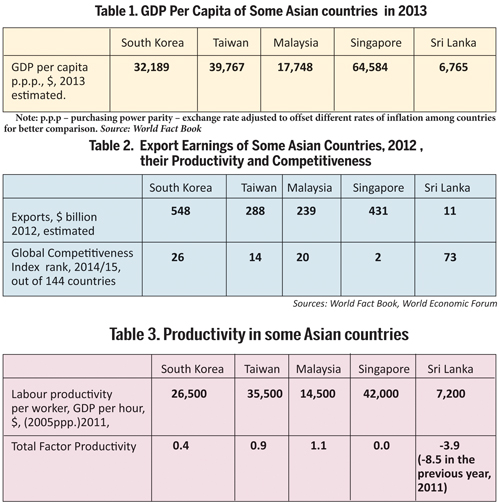Road to prosperity: import substitution or raising export
competitiveness?
The goal of any government in Sri Lanka (SL) should be to improve the
overall well-being of the people mainly by increasing their real incomes
(income adjusted for inflation to increase purchasing power).
|

Lloyd Yapa |
This is needed to reduce poverty and improve the living standards of
the people by raising the level of exports significantly, economic
analyst Lloyd Yapa told Sunday Observer Business.
Excerpts of the interview
Official poverty statistics of SL in the latest Household Income and
Expenditure Survey, 2012-13 of the Department of Census and Statistics (DCS)
are confusing. The DCS figure below the official poverty line is 6.5
percent. But this figure is contradicted by the income distribution data
of the different deciles.
If you calculate poverty using this data you will get a much higher
figure. In fact, 36 percent of the people receive Samurdhi benefits, the
government subsidy given to the poor (according to the Samurdhi
Commissioner). The people are not happy either, the ranking of this
country in the World Happiness Report (John Halliwell, Jeffrey Sachs and
Richard Layard, 2013) is 137 out of 156 countries.
SL is surprisingly poor compared to the other small economies in Asia
such as Singapore, Malaysia, Taiwan and South Korea when GDP per capita
is compared. See table 1.
Poor performance
The picture is much worse if you look at the macroeconomic
indicators. High budget deficits have been prevailing over a long
period. Government revenue is less than its expenditure and it is even
less than the amount needed for servicing the debts (103.3% of revenue
in 2013) of the country.
The huge trade deficit is another issue. Our imports ($ 18 billion in
2013) are almost double that of exports ($10 billion in 2013). This is
the reason why SL has to resort to external borrowing.
Export orientation
What is the strategy to overcome these problems? We have two ways to
increase our economic growth. Boost domestic and foreign demand (export
to the rest of the world). Since SL is a very small island nation with a
population of a little over 20 million and a majority of them poor, our
domestic demand is very low. Therefore, the only option is to increase
exports.
However, our export revenue as a percentage of the GDP has been
declining. It was 33 percent of the GDP in 2004 and in 2013 it had
declined to 16.7 percent. Foreign exchange earnings still largely depend
on the apparel and tea sectors and remittances from migrant workers.
It appears that these high remittances have made us complacent about
expansion of exports. If you look at some other countries in the Asia
region their economies grew mainly by following export orientated
strategies. See table 2.
To boost exports we need investments to expand production capacity
because we should produce goods and services for export. In the recent
past governments signed Free Trade Agreements with India, Pakistan. But
the reality is we don't have goods or services to export and this is the
main reason for the failure of the trade pacts we have signed.
Savings
We have not increased our production capacity to produce goods and
services for export because our investments have been very low. At
present (2013) our total investment is 30 percent of the GDP and we need
to increase it to 35 percent of GDP (some estimates indicate it should
be about 40%). Since our national savings is 26 percent of the GDP
(2013), there is an investment gap of at least 9-10 percent .
As there is no way to increase savings to fill the investment gap,
the only option is to attract Foreign Direct Investments (FDI). Besides
the capital, FDI brings in technology, management skills and global
market access.
Sri Lanka has failed to attract sufficient FDI. For instance, from
2005-2013, Singapore attracted FDI worth US$365 billion, Malaysia US$
125 billion, Taiwan US$ 98 billion compared to only US$ 6 billion by SL
(World Development Reports and World Investment Reports).
In recent years there has been a slight increase in FDI inflows. They
have been mainly for the real estate sector and may not help to boost
exports.
To get back to the need to expand exports to boost economic growth
and increase the real incomes of the people, besides investment
especially in the form of FDI, we need to improve our global
competitiveness (See table 2).
Competition
The latter boils down to improving productivity by increasing future
output and returns from the present input or less of it to reduce unit
costs of goods and services.
At the same time we have to innovate to raise the uniqueness of goods
and services by way of quality and other value added features to satisfy
the needs of different segments of the market while avoiding global
competition. This is the way to obtain higher export earnings.
Today, we export commodities such as tea and rubber or near
commodities such as apparel which fetch low prices in world markets and
not large quantities of value-added goods and services.
Examples of SL firms exporting such unique products are Janet
Cosmetics, Link Natural Products (beauty products and tooth paste),
Hayleys Dipped Products (rubber hand gloves to meet various needs), CEAT
tyres and Loadstar rubber products (pneumatic rubber tyres and solid
rubber tyres). Hayleys and Loadstar are two of the world's largest
manufacturers of tyres of this type.
We need many more of these, as in the case of Malaysia which gained
Independence a couple of years after SL and is now a leading exporter of
electronic equipment, motor vehicles, pharmaceuticals and light
manufactures worth some $230 billion (2012, estimate).
The next major question is how do we significantly improve export
competitiveness while increasing investments? The figures below attempt
to give an answer.
Enabling environment
The enabling environment (EE) in SL during the past three or four
decades was not conducive for investors. In the OECD Country Risk Index,
2014, SL's score was a negative 6 and Somalia's score was 7, (10 being
the worst), while Singapore's score was an excellent 0 and other
international indices.
Separation of powers among the executive, judiciary and the
legislature is essential to improve EE including good governance.
Therefore, the political slogans we hear these days such as reform of
the Constitution to include freedom of expression, right to information,
law and order, new election laws will help to create this enabling
environment.
Law and order is essential for business growth because investors are
concerned about the safety of persons, property, assets and profits.
Macroeconomic stability
Macroeconomic stability too is essential to create a conducive
environment for businesses. Investors are keen on low inflation, low
interest rates and stability of the exchange rate to maintain costs at a
low level. Trade openness by bringing down import tariffs is another
need.
Import tariffs and taxes
Another reason for import tariffs is to protect enterprises producing
for the domestic market. Today, the real effective rate of protection is
reported to be over 200 percent for some commodities such as maize due
to various import tariffs and taxes ( Rajapatirana).
But protectionist mechanisms contribute to price increases of
domestic consumer items and hinder competition or rivalry among firms.
Competition leads to pressure to improve productivity to lower the cost
of production and innovation to improve the quality to meet the needs of
customers and thereby get higher returns.

Note: TFP - the relationship
between output and all inputs like land, labour and capital.
It can also be described as efficiency of production.
Sources: Asian Productivity Organisation and Conference
Board Total Economy Database, 2012/13 |
The solution is to lower import tariffs and taxes to a uniform level.
Protection to a reasonable degree (which causes consumer prices to rise)
can only be accepted in the food sector considering the food security of
the country. But there too competition among such enterprises should be
ensured to protect the consumer by maintaining tariffs at a uniform
level .
Total Factor Productivity in SL has been negative and it was -8.5 in
2011 and -3.5 in 2012 compared to positive figures in other countries in
the region, especially at the beginning of their journey towards
prosperity. See table 3
Therefore, to boost export productivity and competitiveness we have
to invest in the development of the factors of production such as land
(agriculture and fisheries), labour, capital, physical infrastructure,
health, human resources (technical and the soft skills such as
creativity, working effectively in a team) to achieve targets and
communication particularly in a foreign language such as English),
technology and information (at present our investment in education is
1.8 percent of GDP while in Malaysia it is about 6 percent). The policy
decision to increase it to 6 percent is a good move. Liberalisation of
the labour market by simplifying the complexity of labour laws (about
45) in the country, upgrading of skills and the development of the
financial and capital markets to reduce financial risks and costs are
essential to improve not only productivity but also to attract
investments particularly FDI .
Improving productivity, value chains or the supporting industries, is
a responsibility of the State. Planting material production, extension
services, cold rooms, warehouses, transport of produce and marketing
especially in agriculture have to be developed and supported.
Another strategy is to improve the quality of goods and services to
keep pace with international standards. To enhance productivity it is
also important to improve the efficiency of all public institutions
particularly simplification of the complex and cumbersome procedures and
documentation.
It is ironic that setting up of manufacturing industries may support
improvement of productivity in the public sector - by absorbing its
surplus employment about 1.4 million when it can do with one-third the
number) and in agriculture by giving well paid employment opportunities
to the excess labour in the sector (about 31% of total employment). Else
consolidation of agricultural holdings to improve productivity in the
sector may throw out more than a million subsistence farmers who cannot
obtain a farm surplus.
Institutional arrangements
Expansion of exports involves a number of public institutions dealing
with planning, laws, policies and incentives connected with investment,
production of goods and services, improvement of productivity, export
competitiveness and promotion of exports in global markets.
It is thus clear that is not the sole responsibility of the EDB and
the Department of Commerce which are at present engaged only in export
promotion (difficult without sufficient goods and services).
Thus, the solution may be to bring the EDB, the Department of
Commerce and the BOI under the supervision of the Ministry of Finance
and Planning for greater co-ordination and effectiveness.
Achieving prosperity and alleviation of poverty is a matter of
increasing investment especially FDI and improving productivity and
competitiveness to differentiate goods and services to satisfy customers
especially in global markets.
Import substitution should only be for special needs such as
maintaining food security as SL is a small country with a small domestic
market.
- GW |

